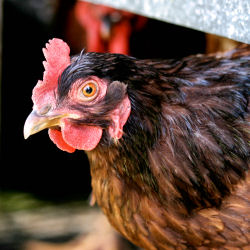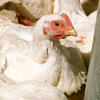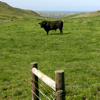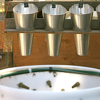Out to pasture
 Before Niman Ranch started raising their herds on Iowa feedlots, their marketing materials bragged about “happy cows with ocean views”. Last Sunday, as we popped over the crest of Pierce Point Road and saw limitless green pasture dotted with black steers overlooking the deep blue waters of the Pacific, I gasped: It was exactly the scene that I’d held in my mind’s eye all these years. Only this land and these cattle belong to Marin Sun Farms, the ranch that supplies us with most of our eggs and meat.
Before Niman Ranch started raising their herds on Iowa feedlots, their marketing materials bragged about “happy cows with ocean views”. Last Sunday, as we popped over the crest of Pierce Point Road and saw limitless green pasture dotted with black steers overlooking the deep blue waters of the Pacific, I gasped: It was exactly the scene that I’d held in my mind’s eye all these years. Only this land and these cattle belong to Marin Sun Farms, the ranch that supplies us with most of our eggs and meat.
Even a week after our visit, I’m having a hard time expressing the depth of my awe for what David Evans is doing out on his Historic H Ranch, just 50 miles north of San Francisco. David’s family has farmed this same land since the early 1900s, although they were forced to sell it in the 1970s under the eminent domain act that created the Point Reyes National Seashore. The family leases back the land under what seems to be very tenuous circumstances: 5 year terms and government oversight of terribly minute details like the size of chicken flocks. Needless to say, it’s not the sort of sustainable permanence that makes this consumer particularly content.
Pronounced David’s way, the enterprise responsible for much of our weekly protein is properly known as “Marin Sun Farms” not “Marin Sun Farms.” Like his mentor Joel Salatin — who famously explained to Michael Pollan that he was a “grass farmer” — David takes pains to emphasize that his husbandry converts solar energy, by way of living pasture, into proteins that humans can digest. It’s half clever and half hokey, but undeniably true.
We started our tour overlooking the pasture where cows and calves ambled up and down spring-green hills, lolling in the lush grass or drinking from a large, clear pond. David talked at length about his ideology and his farming methods, explaining how herds — both chickens and cows — are moved to a different patch of land each week, preserving the pasture from over-grazing and enhancing the soil with their manure.
We peeked into a converted freight trailer turned chicken nursery, spying four gaggles of Easter-perfect chicks peeping around under heat lamps, pecking away at their feed. From there, we strolled down a wide lane to look in on David’s sister’s goat herd, busily clearing a scrubby yard where vegetables had been grown over the previous winter.
Beyond the goat yard, we saw two quonset hut-shaped structures on a distant hillside, our first glimpse of the farm’s egg-laying operation. Built of canvas-like material stretched over simple wood frames, these chicken houses open directly onto open pasture, without any physical barriers to any one of the chickens flying or wandering off. Apparently their social structure makes that unlikely; they’re much more apt to leave in the clutches of a predator, according to David. Perhaps half of the chickens roosted inside their homes, and the remainder scratched and pecked and flapped away outside in the open air. Glancing at the wide range of breeds, I suddenly understood the diversity of the colors and sizes of the eggs in our weekly dozen.
Many of us remarked with surprise that this egg-laying flock included a fairly large number of roosters, in addition to the laying hens. “I don’t do it so we can say the eggs are fertile,” said David, “But I know that I wouldn’t be happy in an environment without females, and I don’t think any of you ladies would be happy in a world without men.” Even as an unrepentant omnivore, it’s hard to wrap your brain around someone who makes his living selling meat treating his product with such humane regard.
Up the road a piece, we called on the broiler flocks, grown-up versions of the fuzzy peeps we’d seen pecking in the nursery. Penned in movable, mesh-covered yards — half in sun, half in shade — these birds were, quite frankly, the ugly ducklings of the farm. Where the laying hens are diverse and beautiful, Cornish Cross broilers look like the freaks of nature we’ve bred them to be. Sparsely feathered, dull around the eyes, and unbelievably gawky, these aren’t birds you feel too much sentiment toward. Still, they’re cared for with the same meticulous attention. They’re fed organic cracked grain, supplementing all the insects and grubs they can forage from their patch of pasture. At the end of the week, when they’ve cleared the pests and fertilized the land beneath their enclosures, their coops are canted up on a large dolly and rolled forward to a new stretch of green grass.
Sounds bucolic, and it certainly looks that way, too. Are things 100% perfect on this pastoral land? I’m sure they’re not. I would have been happier not knowing that Marin Sun Farms broiler chicks are fed imported Chinese soy until they’re old enough to digest corn and grubs. Or that David feels that heirloom birds are just too expensive (twice the cost of the already pricey hybrids he brings to market, he says) and don’t taste any better than the ugly mutants. Or that most of the calves born at his parents’ H Ranch operation are destined for life on the feedlots of the Midwest, because there simply isn’t enough demand for pasture-raised beef. But despite all of the things that I wish they were doing more-perfectly, the simple fact is that I am in awe of the 99% that Marin Sun Farms is doing exactly right.
Rounding our way back to the main barn, David stopped to talk about the on-farm ‘processing’ — that is, slaughtering — that farmers are, thankfully, still allowed to do for their own poultry. As he explained that the next part of the tour was occasionally more than some visitors had bargained for, I finally focused beyond David’s shoulder, at last noticing a critical part of the farm that had previously escaped my notice. Having read Michael Pollan’s description of the Polyface Farms “abattoir without walls,” I knew enough to recognize it: The metal cones where chickens are killed and bled out, the plucking machine with its hundred rubber ‘fingers’, the well-worn worktables, the buckets for the blood and guts that get turned into the compost pile to amend the land. No roof, no walls; everything open to the sun and the wind, nature’s original sanitizers. It was all right there… right there for anyone to see, to understand.
I knew well enough we wouldn’t see any chickens slaughtered that Sunday — it happens on Thursdays, anyway, and the oldest of this season’s broilers were still a week from market, merrily clucking away in the pasture. Nothing had been slaughtered here since the old roosters and hens had come to market last winter; the killing place smelled of nothing but the hillside around us. And yet, it had the undeniable air of purpose. I won’t insult you by saying it felt holy, but I do know that there was no nervous laughter, no chatter, no wandering off to investigate something more interesting around the corner. Every one of us on that tour, kids included, was completely present there, standing inside the boundaries of the place where animals became food: The place where each bird experiences what David calls its “one bad day” on the farm.
—-
When the tour was over, we caravaned back over the road to Route 1. David treated everyone to lunch at the Marin Sun Farms Butcher Shop, a bountiful spread of Della Fattoria bread, the farm’s own rib eye and roast goat, bowlsful of aioli and horseradish cream and salsa verde, and buckets of German-style potato salad with flecked with rich bacon.
But the best part of the lunch was the beverage: David brought out “a gift” — which he couldn’t legally sell to us — of a few gallons of raw milk “just hours out of the cow” in oversized Mason jars. I’d shied away from buying raw milk at the stores, imagining that it would taste grassy or gamey. But oh, lord, what I’d been missing! It just tasted more milk-y, like a better version of the best milk you’ve ever had. Nuances of flavor, texture, and color are apparent even to the most casual observer.
Needless to say, we bought a quart of Claravale raw milk this Saturday, and I don’t expect to go back to the sterile, flat stuff anytime soon. Nor do I expect I will soon forget the windy spring morning when I looked my supper in the eye and made peace with my place on this sustainable food chain.
Marin Sun Farms
10905 Shoreline Highway
Point Reyes Station, CA 94956
415-663-8997
Meat CSA memberships available starting at $270 for a 6-month session
Retail sales available at the Point Reyes butcher shop, Saturday Ferry Plaza Farmers Market and Sunday San Rafael Civic Center Farmers Market
Next farm tour: May 18, 2008
Adults $30, Kids $10
(Pre-registration is mandatory)









Comment by gilrain
Very nice write-up! Your posts always make me half-consider moving up there. I imagine, though, there might be similar options around San Diego, my home base, if I take the time to look!
Incidentally, why couldn’t he legally sell you raw milk? I can buy raw milk from Whole Foods — I thought CA was one of the few states where it _is_ legal.
Posted on 04.07.08 at 1:20AM
Comment by Anita
Thanks, Gilrain. I think you’re probably right about SoCal options being plentiful, although they may be harder to suss out.
You’re right that California is one of the places were raw milk sales are legal. But I think that in order to sell it to the public, dairies have to submit samples for testing and jump through a lot of hoops. I’m certainly no expert on this, though — maybe someone else will chime in. In the case of the lunch at MSF, what I know is limited to what David told us.
Posted on 04.07.08 at 7:13AM
Comment by Jennifer Hess
Wonderful post.
Posted on 04.07.08 at 8:40AM
Comment by Alan
Thanks for the heads up about the meat CSA. My wife and I rarely eat meat b/c we can’t afford to buy sustainably raised animals. We love marin sun farms products and this option will make it a little more doable for us.
Posted on 04.07.08 at 9:55AM
Comment by cookiecrumb
Well done. I felt like I was with you. (Why wasn’t I with you!?) 😀
I’m so excited about the new chickens. Just what I need to jump-start my appetite.
Thanks, Anita.
Posted on 04.07.08 at 9:57AM
Comment by Anita
Jennifer: Thanks 🙂
Alan: So glad that we could pass the word on. The CSA seems to be a fabulous bargain, at least for us, and the side benefit is that — like a veggie CSA — we’re getting to try things we might not have picked out on our own. David says they’re looking into having another SF pickup location, for those folks who can’t make it to Dogpatch during their limited business hours.
Cookie: Yeah, hmm, why weren’t you with us? Probably because by the time I thought to mention it, they’d already sold out. But if you guys decide to visit, we’d gladly come along.
Posted on 04.07.08 at 10:54AM
Comment by Denise and Lenny
So well written, I felt like we were right there with you, even tasting that wonderful milk. I have been on the fence about trying raw milk; but, you have changed my mind here. I may have to try to get us on one of these tours as well.
Thanks for the info!!
Posted on 04.07.08 at 10:56AM
Comment by Tana
A very thoughtful, informative, and good post, worthy of the time it took you to write, and me to read.
: D
Posted on 04.07.08 at 3:02PM
Comment by Tartelette
That’s it! I am on the next plane!! Actually, I did find raw milk at the farmers’ market last year and I have been buying it ever since. It brings me back to my childhood days. Great write up, very thoughtful and I felt like I was there!
Posted on 04.08.08 at 5:22PM
Pingback by Urban Hennery » Blog Archive » Dark Days 2008: Finale
[…] Anita explored the perfect Reuben, taking advantage of the leftover homemade corned beef that she had. Then they literally went out to meet their dinner, touring Marin Sun Farms, the ranch that supplies most of their eggs and meat. Finally she reflects on the challenge, the last few meals and the arrival of spring. Isn’t that purple asparagus gorgeous? We’re still easily a month away from asparagus here, and two from strawberries. But maybe if I close my eyes and visualize I can enjoy those first bites of spring with Anita. Thanks Anita, your meals were truly an inspiration this winter. […]
Posted on 04.08.08 at 11:26PM
Comment by Lee
Mmmm…raw milk. It’s hard to find in WI but it’s so worth the effort. I’ve got to get some soon.
Great post! I finally put you in my google reader so I will stay caught up. I don’t read many blogs anymore but yours is one of the few!
Posted on 04.10.08 at 10:33AM
Comment by nicole
I just love it out there! I have been passing by the ‘H’ since I was a kid, and it’s great to know what it’s all about. Though I must admit I’m not a meat-eater, your lunch sounds utterly fabulous. What a wonderful day.
Posted on 04.10.08 at 3:25PM
Pingback by Married …with dinner » Blog Archive » Lazy, hazy days
[…] Luckily, we had an ace in the hole planned for mid-week. Our meat CSA has given us a surplus of ground beef. Throw it in a skillet with in a hunk of Fatted Calf chorizo, a couple of the season’s first peppers from Happy Quail, a jar of homemade tomato sauce, and some local onions and garlic: Voilá, instant Sloppy Joes. Paired with a side of bacon-lashed coleslaw, we had ourselves a perfectly fabulous — and 100%-local — quick summer meal. Not glamorous, but definitely delicious. […]
Posted on 06.30.08 at 6:50PM